ESP SKODA OCTAVIA TOUR 2009 1.G / (1U) Owner's Guide
[x] Cancel search | Manufacturer: SKODA, Model Year: 2009, Model line: OCTAVIA TOUR, Model: SKODA OCTAVIA TOUR 2009 1.G / (1U)Pages: 226, PDF Size: 13.11 MB
Page 133 of 226
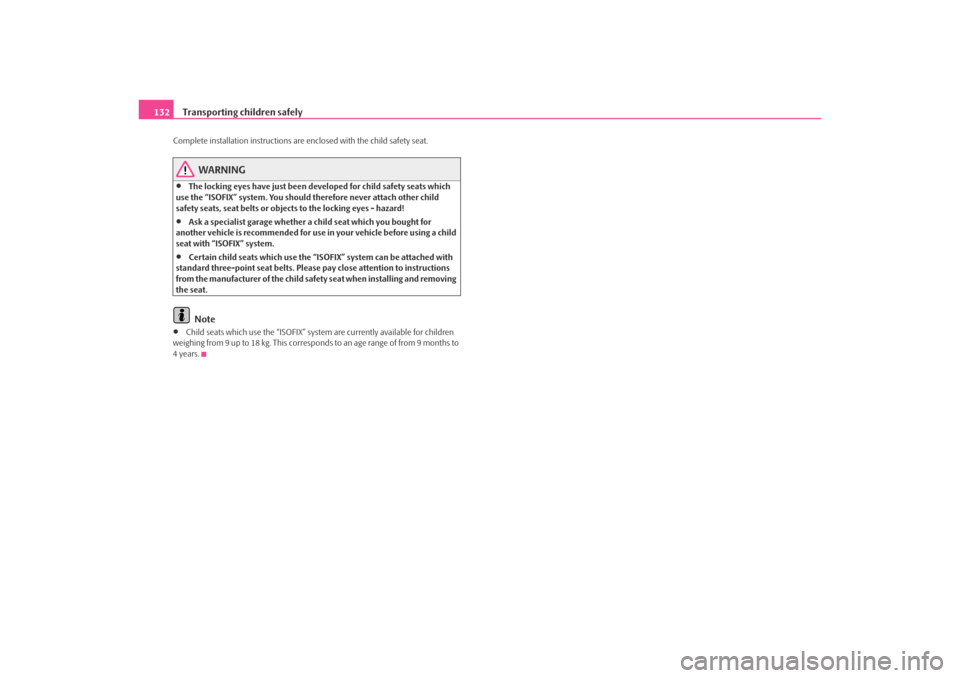
Transporting children safely
132Complete installation instructions are enclosed with the child safety seat.
WARNING
•
The locking eyes have just been developed for child safety seats which
use the “ISOFIX” system. You should therefore never attach other child
safety seats, seat belts or obje cts to the locking eyes - hazard!
•
Ask a specialist garage whether a child seat which you bought for
another vehicle is recommended for use in your vehicle before using a child
seat with “ISOFIX” system.
•
Certain child seats which use the “ISOFIX” system can be attached with
standard three-point seat belts. Please pay close attention to instructions
from the manufacturer of the child safety seat when installing and removing
the seat.Note
•
Child seats which use the “ISOFIX” system are currently available for children
weighing from 9 up to 18 kg. This correspo nds to an age range of from 9 months to
4 years.
s2ig.book Page 132 Monday, November 10, 2008 11:20 AM
Page 134 of 226

Intelligent Technology133
Using the system
Safety
Driving Tips
General Maintenance
Breakdown assistance
Technical Data
Driving TipsIntelligent TechnologyElectronic stability programme (ESP)*GeneralGeneral
The ESP aids you maintain control of your vehicle in situations in borderline driving
situations such as when negotiating a curve too fast. The risk of skidding is reduced
and your car thus offers greater driving stability depending on the conditions of the
road surface. This occurs at all speeds.
The following systems are integrated into the electronic stability programme:•
Electronic Differential Lock (EDL),
•
Traction control system (TCS),
•
Antilock brake system (ABS),
•
Brake Assist. Operating principle
The ESP switches on automatically when the engine is started and then conducts a
self-test. The ESP control unit processes data from the individual systems. It also
processes additional measurement data which are supplied by highly sensitive
sensors: the rotational velocity of the vehi
cle about its vertical axis, the lateral accel-
eration of the vehicle, the brakin g pressure and the steering angle.
The direction which the driver wishes to ta ke is determined based on the steering
angle and the speed of the vehicle and is constantly compared with the actual
behaviour of the vehicle. If differences exis t, such as the car beginning to skid, the
ESP will automatically brake the appropriate wheel.
The car is stabilised again by the forces which take effect when the wheel is braked.
Intervention into the brake system takes place primarily on the outer front wheel of
a vehicle which tends to oversteer (tendency for the rear of the vehicle to break
away) while occurs this is on the inner re ar wheel of a vehicle which tends to under-
steer (tendency to shift out of the curve). This braking control cycle is accompanied
by noises.
The ESP operates in combination with the ABS ⇒page 137, “Antilock brake system
(ABS)*”. If there is a fault in the ABS system, the ESP also does not operate.
The ESP warning light ⇒page 33 lights up in the instrument cluster when there is a
fault on the ESP.
Switching off
You can switch the ESP off and on again as you wish, by pressing the button
⇒ fig. 141 . The ESP warning light ⇒page 33 lights up in the instrument cluster
when the ESP is switched off.
The ESP should normally always be switched on. It may be good practice in certain
exceptional cases, such as when you wish to have wheel slip, to switch off the
system.
Examples:
Fig. 141 ESP switch
s2ig.book Page 133 Monday, November 10, 2008 11:20 AM
Page 135 of 226
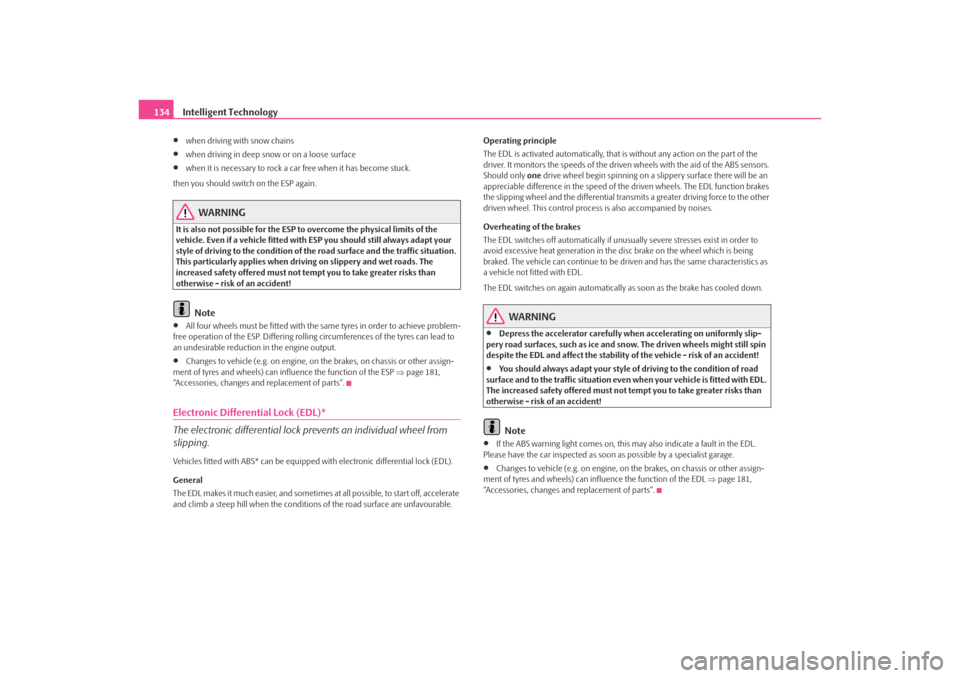
Intelligent Technology
134•
when driving with snow chains
•
when driving in deep snow or on a loose surface
•
when it is necessary to rock a ca r free when it has become stuck.
then you should switch on the ESP again.
WARNING
It is also not possible for the ESP to overcome the physical limits of the
vehicle. Even if a vehicle fitted with ESP you should still always adapt your
style of driving to the condition of the road surface and the traffic situation.
This particularly applies when driving on slippery and wet roads. The
increased safety offered must not tempt you to take greater risks than
otherwise - risk of an accident!
Note
•
All four wheels must be fitted with the same tyres in order to achieve problem-
free operation of the ESP. Differing rollin g circumferences of the tyres can lead to
an undesirable reduction in the engine output.
•
Changes to vehicle (e.g. on engine, on the brakes, on chassis or other assign-
ment of tyres and wheels) can influence the function of the ESP ⇒page 181,
“Accessories, changes and replacement of parts”.
Electronic Differential Lock (EDL)*
The electronic differential lock pr events an individual wheel from
slipping.Vehicles fitted with ABS* can be equipped with electron ic differential lock (EDL).
General
The EDL makes it much easier, and sometimes at all possible, to start off, accelerate
and climb a steep hill when the conditio ns of the road surface are unfavourable. Operating principle
The EDL is activated automatically, that is
without any action on the part of the
driver. It monitors the speeds of the driven wheels with the aid of the ABS sensors.
Should only one drive wheel begin spinning on a slippery surface there will be an
appreciable difference in the speed of the driven wheels. The EDL function brakes
the slipping wheel and the differential transmits a greater driving force to the other
driven wheel. This control proces s is also accompanied by noises.
Overheating of the brakes
The EDL switches off automatically if unusually severe stresses exist in order to
avoid excessive heat generation in the disc brake on the wheel which is being
braked. The vehicle can continue to be dr iven and has the same characteristics as
a vehicle not fitted with EDL.
The EDL switches on again automatically as soon as the brake has cooled down.
WARNING
•
Depress the accelerator carefully when accelerating on uniformly slip-
pery road surfaces, such as ice and sn ow. The driven wheels might still spin
despite the EDL and affect the stability of the vehicle - risk of an accident!
•
You should always adapt your style of driving to the condition of road
surface and to the traffic situation even when your vehicle is fitted with EDL.
The increased safety offered must not tempt you to take greater risks than
otherwise - risk of an accident!Note
•
If the ABS warning light comes on, this ma y also indicate a fault in the EDL.
Please have the car inspected as soon as possible by a specialist garage.
•
Changes to vehicle (e.g. on engine, on the brakes, on chassis or other assign-
ment of tyres and wheels) can in fluence the function of the EDL ⇒page 181,
“Accessories, changes and replacement of parts”.
s2ig.book Page 134 Monday, November 10, 2008 11:20 AM
Page 153 of 226
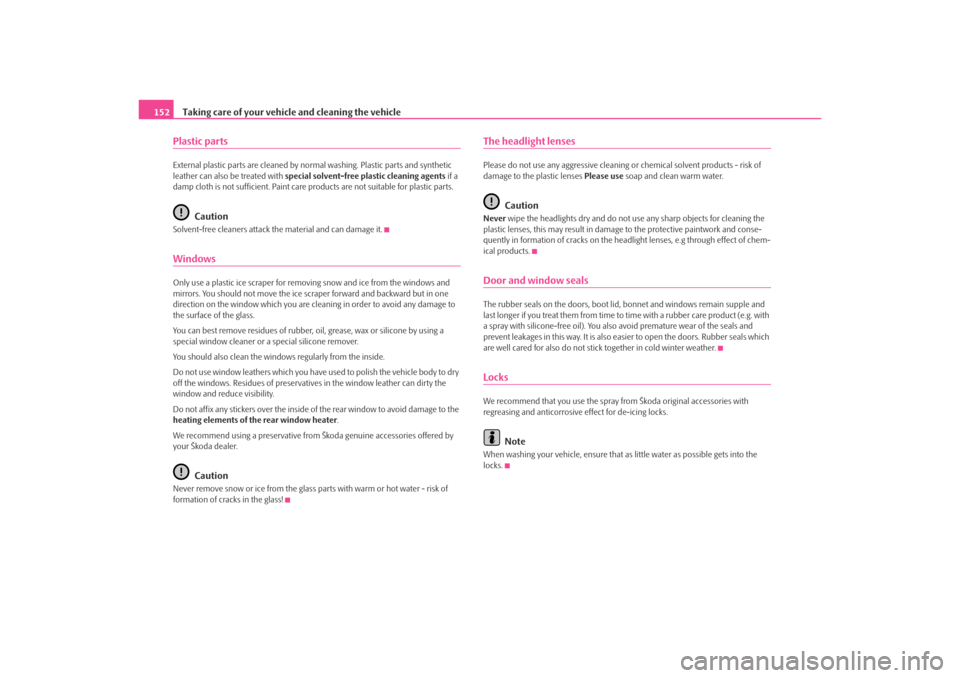
Taking care of your vehicle and cleaning the vehicle
152Plastic partsExternal plastic parts are cleaned by normal washing. Plastic parts and synthetic
leather can also be treated with special solvent-free plastic cleaning agents if a
damp cloth is not sufficient. Paint care pr oducts are not suitable for plastic parts.
Caution
Solvent-free cleaners attack the material and can damage it.WindowsOnly use a plastic ice scraper for removing snow and ice from the windows and
mirrors. You should not move the ice scraper forward and backward but in one
direction on the window which you are clea ning in order to avoid any damage to
the surface of the glass.
You can best remove residues of rubber, oil, grease, wax or silicone by using a
special window cleaner or a special silicone remover.
You should also clean the windows regularly from the inside.
Do not use window leathers which you have used to polish the vehicle body to dry
off the windows. Residues of preservati ves in the window leather can dirty the
window and reduce visibility.
Do not affix any stickers over the inside of the rear window to avoid damage to the
heating elements of the rear window heater .
We recommend using a preservative from Škoda genuine accessories offered by
your Škoda dealer.
Caution
Never remove snow or ice from the glass parts with warm or hot water - risk of
formation of cracks in the glass!
The headlight lensesPlease do not use any aggres sive cleaning or chemical solvent pr oducts - risk of
damage to the plastic lenses Please use soap and clean warm water.
Caution
Never wipe the headlights dry and do not use any sharp objects for cleaning the
plastic lenses, this may result in damage to the protective paintwork and conse-
quently in formation of cracks on the head light lenses, e.g through effect of chem-
ical products.Door and window sealsThe rubber seals on the doors, boot lid, bonnet and windows remain supple and
last longer if you treat them from time to time with a rubber care product (e.g. with
a spray with silicone-free oil). You also avoid premature wear of the seals and
prevent leakages in this way. It is also easier to open the doors. Rubber seals which
are well cared for also do not stick together in cold winter weather.LocksWe recommend that you use the spray from Škoda original accessories with
regreasing and anticorrosive effect for de-icing locks.
Note
When washing your vehicle, ensure that as little water as possible gets into the
locks.
s2ig.book Page 152 Monday, November 10, 2008 11:20 AM
Page 159 of 226

Fuel
158•
Your vehicle is not adapted for use of biof uel (RME), therefore this fuel must not
be refuelled and driven. Using this fuel (R ME) can lead to damage to the engine or
the fuel system.
Operation in winterWinter-grade diesel fuel
A different grade of diesel fuel is available at filling stations in winter than during the
summer. Using “summer-grade diesel fuel” at temperatures below 0°C can result
in operational problems because the diesel becomes viscous as a result of paraffin
separation.
It is therefore the case that DIN EN 590 prescribes diesel fuel class for certain
periods of the year which can also be pu rchased at the corresponding time during
the year. “Winter-grade diesel fuel” will still operate properly even at a temperature
of -20°C.
It is often the case in countries with diff erent climatic conditions that diesel fuels
available have a different temperature characteristic. The specialist garages and
filling stations in the country concerned wi ll be able to provide you with informa-
tion regarding the diesel fuels available.
Prewarming fuel
The vehicle is fitted with a fuel filter prewarming system. This secures operation of
a vehicle using diesel fuel down to an environmental temperature of -25°C.
Caution
It is not permitted to add the various fuel additives on the market, including petrol,
to diesel fuel in order to improve its flow properties.
RefuellingThe filler tube of the fuel reservoir is located in the rear right side part of
the vehicle.
Opening the fuel filler cap
– Open the fuel filler flap with the hand.
– On vehicles without remote unlocking of the fuel filler flap from the
driver's seat, unlock the fuel filler cap on the fuel filler tube by turning
the vehicle key to the left.
Fig. 147 Switch for opening
the fuel filler flap from the
driver seatFig. 148 Filler flap with cap
unscrewed
s2ig.book Page 158 Monday, November 10, 2008 11:20 AM
Page 180 of 226
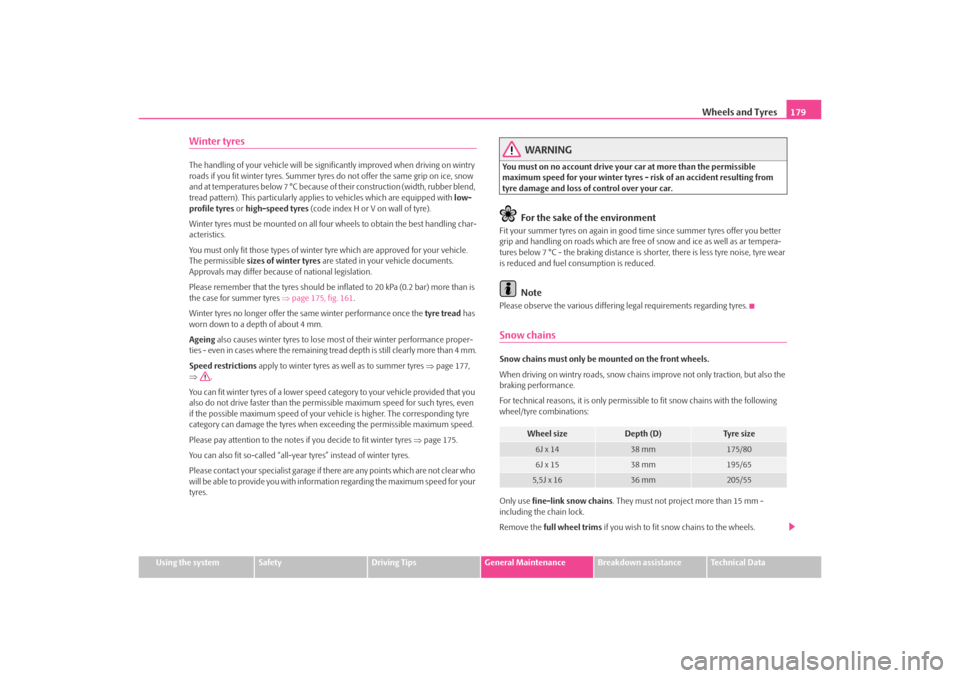
Wheels and Tyres179
Using the system
Safety
Driving Tips
General Maintenance
Breakdown assistance
Technical Data
Winter tyresThe handling of your vehicle will be significantly improved when driving on wintry
roads if you fit winter tyres. Summer tyres do not offer the same grip on ice, snow
and at temperatures below 7 °C because of their construction (width, rubber blend,
tread pattern). This partic ularly applies to vehicles which are equipped with low-
profile tyres or high-speed tyres (code index H or V on wall of tyre).
Winter tyres must be mounted on all four wheels to obtain the best handling char-
acteristics.
You must only fit those type s of winter tyre which are approved for your vehicle.
The permissible sizes of winter tyres are stated in your vehicle documents.
Approvals may differ becaus e of national legislation.
Please remember that the tyres should be in flated to 20 kPa (0.2 bar) more than is
the case for summer tyres ⇒page 175, fig. 161 .
Winter tyres no longer offer the same winter performance once the tyre tread has
worn down to a depth of about 4 mm.
Ageing also causes winter tyres to lose mo st of their winter performance proper-
ties - even in cases where the remaining tread depth is still clearly more than 4 mm.
Speed restrictions apply to winter tyres as well as to summer tyres ⇒page 177,
⇒ .
You can fit winter tyres of a lower speed ca tegory to your vehicle provided that you
also do not drive faster than the permis sible maximum speed for such tyres, even
if the possible maximum speed of your ve hicle is higher. The corresponding tyre
category can damage the tyres when exceeding the permissi ble maximum speed.
Please pay attention to the notes if you decide to fit winter tyres ⇒page 175.
You can also fit so-called “all-year tyres” instead of winter tyres.
Please contact your specialist garage if there are any points which are not clear who
will be able to provide you with information regarding the maximum speed for your
tyres.
WARNING
You must on no account drive your car at more than the permissible
maximum speed for your winter tyres - risk of an accident resulting from
tyre damage and loss of control over your car.
For the sake of the environment
Fit your summer tyres on again in good ti me since summer tyres offer you better
grip and handling on roads which are free of snow and ice as well as ar tempera-
tures below 7 °C - the braking distance is shorter, there is less tyre noise, tyre wear
is reduced and fuel consumption is reduced.
Note
Please observe the various differing legal requirements regarding tyres.Snow chainsSnow chains must only be mounted on the front wheels.
When driving on wintry roads, snow chains improve not only traction, but also the
braking performance.
For technical reasons, it is only permissi ble to fit snow chains with the following
wheel/tyre combinations:
Only use fine-link snow chains . They must not project more than 15 mm -
including the chain lock.
Remove the full wheel trims if you wish to fit snow chains to the wheels.
Wheel size
Depth (D)
Ty re s i z e
6J x 14
38 mm
175/80
6J x 15
38 mm
195/65
5,5J x 16
36 mm
205/55
s2ig.book Page 179 Monday, November 10, 2008 11:20 AM
Page 182 of 226

Accessories, changes and replacement of parts181
Using the system
Safety
Driving Tips
General Maintenance
Breakdown assistance
Technical Data
Accessories, changes and replacement of partsAccessories and replacement partsŠkoda vehicles have been built according to the latest discoveries in safety engi-
neering. Thus one should no t change the condition in which the vehicle was deliv-
ered from the manufacturer without some thought.
The following guidelines should be observed when a vehicle is to be retrofitted with
accessories, have technical ch anges made to it or a par t has to be replaced at some
time in the future.•
Advise should always be obtained from a specialist garage before buying any
accessories and before making any technical changes ⇒.
•
This is particularly the case when acce ssories are bought in a foreign country.
•
Škoda Genuine Accessories which have b een released for use and Skoda orig-
inal parts can be bought from specialist garages that professionally undertake the
assembly of parts which were not purchased there.
•
All Škoda original accessories which are listed in the catalogue of original acces-
sories such as tilting roofs, spoile rs, wheel rims etc. are homologized.
•
Radios, aerials and other electrical acce ssories should only be installed by a
specialist garage.
•
The guidelines issued by Škoda Auto a.s. must be observed when making tech-
nical changes.
•
This is to ensure that no technical damage occurs to the vehicle, that travelling
and operating safety are maintained and that the chnages are permissible. The
specialist garages also undertake this work professionally or refer it to a specialist
garage in special cases.
Any damage which is done caused by technical changes made without
consulting a Skoda a.s. dealer is excluded from the guarantee.
WARNING
•
We advise you, in your own interest, to only use Škoda Genuine Accesso-
ries and Škoda original parts which have been expressly approved for use on your Škoda. Reliability, safety and su
itabiliity have been established for
these Škoda original parts.
•
We cannot guarantee suitability of installation into your vehicle of other
products despite keeping a constant ey e on market developments (also not
in the case where there is an attestation or permission can be produced).
Technical changesInterference on the electronic components and their software can lead to opera-
tional faults. This interference can also impair not directly affected systems because
of the networking of the electronic co mponents. This means that the operating
safety of your vehicle can be considerably jeopardized, a greater wear of vehicle
parts can occur and finally the vehi cle registration documents expire.
We trust that you will understand that Škoda Auto cannot be liable for damage
resulting from unprofessional work.
We therefore recommend that you have all work carried out with Škoda original
parts at specialist garages.
WARNING
Work or modifications on your vehicle, which have been carried out unpro-
fessionally, can cause operational faults - risk of accident!
WARNING (continued)
s2ig.book Page 181 Monday, November 10, 2008 11:20 AM
Page 195 of 226

Fuses and light bulbs
194Fuses and light bulbsElectric fusesReplacing fuses
Defect fuses must be replaced.Individual electrical circuits are prot ected by fuses. The fuses are located
on the left side of the dash panel behind the safety cover and under the
cover in the engine compartment on the left.
– Switch the ignition off and also the electrical component affected.
– Use a screwdriver to take off the fuse cover on the side of the dash panel ⇒fig. 177 or the fuse cover in the engine compartment
⇒ page 195.
– Find out which fuse belongs to the relevant component ⇒page 196,
“Fuse assignment in the dash panel”, ⇒page 195, “Fuse assignment
in engine compartment - version 1” or ⇒page 196, “Fuse assignment
in engine compartment - version 2”.
– Take the plastic clip out of its fixture in the fuse cover, insert it onto the respective fuse and pull out this fuse. – Defect fuses can be detected by th
eir melted metal strips. Replace the
defect fuse by a new fuse of the same ampere number.
– Fit on the fuse cover again.
We recommend that you carry the box of replacement fuses with you which was
delivered in your vehicle. Replacement fu ses are available at specialist garages
7).
Colour coding of fuses
Caution
•
Never attempt to “repair” fuses and also do not replace them with a fuse of a
higher amperage - risk of fire! This may also cause damage at another part of the
electrical system.
•
Have the electrical system checked as quickly as possible by a specialist garage
if a newly inserted fuse blows again after a short time.
Fig. 177 Fuse cover: left side
of the dash panel
7)Replacement fuses are, on the other hand, part of the basic equipping of the vehicle in some
countries.
Colour
Maximum amperage
light brown
5
brown
7,5
red
10
blue
15
yellow
20
white
25
green
30
s2ig.book Page 194 Monday, November 10, 2008 11:20 AM
Page 197 of 226
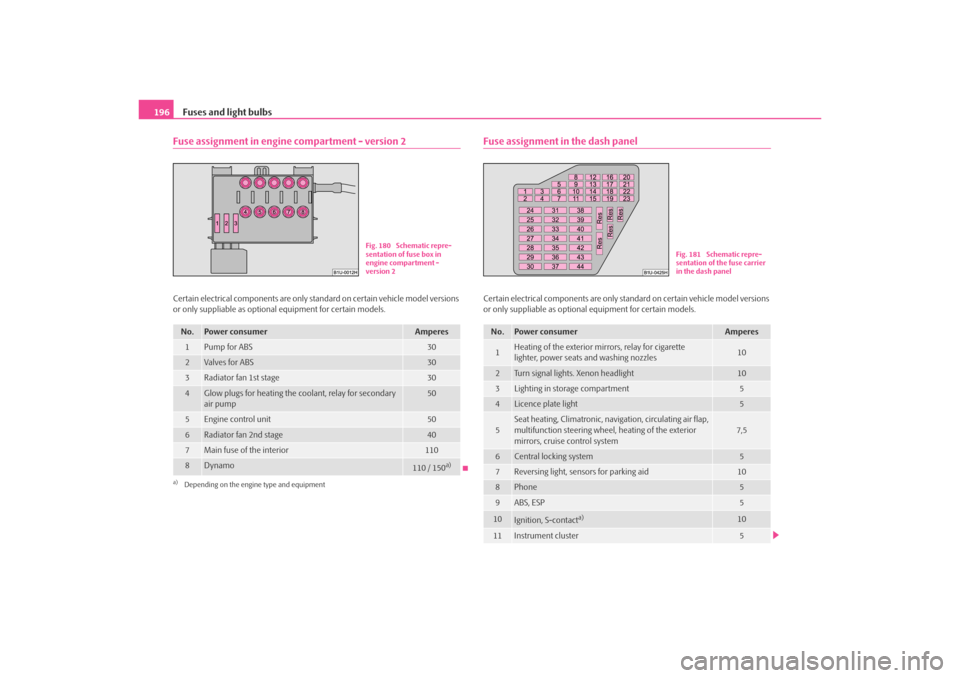
Fuses and light bulbs
196Fuse assignment in engine compartment - version 2Certain electrical components are only st andard on certain vehicle model versions
or only suppliable as optional equipment for certain models.
Fuse assignment in the dash panelCertain electrical components are only standard on certain vehicle model versions
or only suppliable as optional equipment for certain models.
No.
Power consumer
Amperes
1
Pump for ABS
30
2
Valves for ABS
30
3
Radiator fan 1st stage
30
4
Glow plugs for heating the coolant, relay for secondary
air pump
50
5
Engine control unit
50
6
Radiator fan 2nd stage
40
7
Main fuse of the interior
110
8
Dynamo
110 / 150
a)
a)Depending on the engine type and equipment
Fig. 180 Schematic repre-
sentation of fuse box in
engine compartment -
version 2
No.
Power consumer
Amperes
1
Heating of the exterior mirrors, relay for cigarette
lighter, power seats and washing nozzles
10
2
Turn signal lights. Xenon headlight
10
3
Lighting in storage compartment
5
4
Licence plate light
5
5
Seat heating, Climatronic, navigation, circulating air flap,
multifunction steering wheel, heating of the exterior
mirrors, cruise control system
7,5
6
Central locking system
5
7
Reversing light, sensors for parking aid
10
8
Phone
5
9
ABS, ESP
5
10
Ignition, S-contact
a)
10
11
Instrument cluster
5
Fig. 181 Schematic repre-
sentation of the fuse carrier
in the dash panel
s2ig.book Page 196 Monday, November 10, 2008 11:20 AM
Page 201 of 226
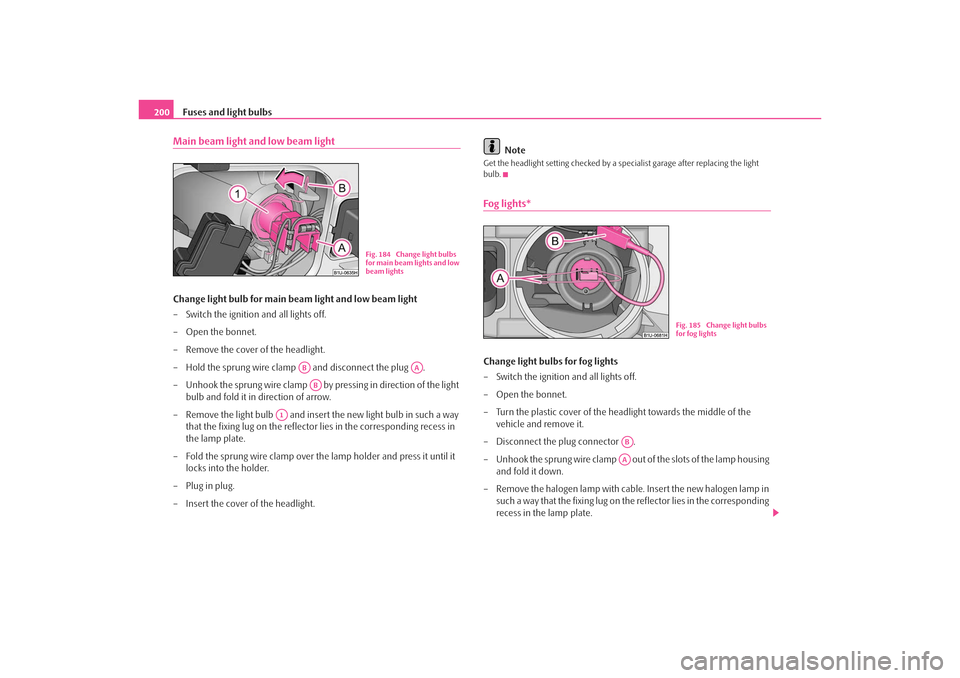
Fuses and light bulbs
200Main beam light and low beam lightChange light bulb for main beam light and low beam light
– Switch the ignition and all lights off.
– Open the bonnet.
– Remove the cover of the headlight.
– Hold the sprung wire clamp and disconnect the plug .
– Unhook the sprung wire clamp by pressing in direction of the light
bulb and fold it in direction of arrow.
– Remove the light bulb and insert the new light bulb in such a way that the fixing lug on the reflector lies in the corresponding recess in
the lamp plate.
– Fold the sprung wire clamp over the lamp holder and press it until it
locks into the holder.
–Plug in plug.
– Insert the cover of the headlight. Note
Get the headlight setting checked by a specialist garage after replacing the light
bulb.Fog lights*Change light bulbs for fog lights
– Switch the ignition and all lights off.
– Open the bonnet.
– Turn the plastic cover of the head
light towards the middle of the
vehicle and remove it.
– Disconnect the plug connector .
– Unhook the sprung wire clamp out of the slots of the lamp housing and fold it down.
– Remove the halogen lamp with cable. Insert the new halogen lamp in such a way that the fixing lug on th e reflector lies in the corresponding
recess in the lamp plate.
Fig. 184 Change light bulbs
for main beam lights and low
beam lights
AB
AA
AB
A1
Fig. 185 Change light bulbs
for fog lights
ABAA
s2ig.book Page 200 Monday, November 10, 2008 11:20 AM